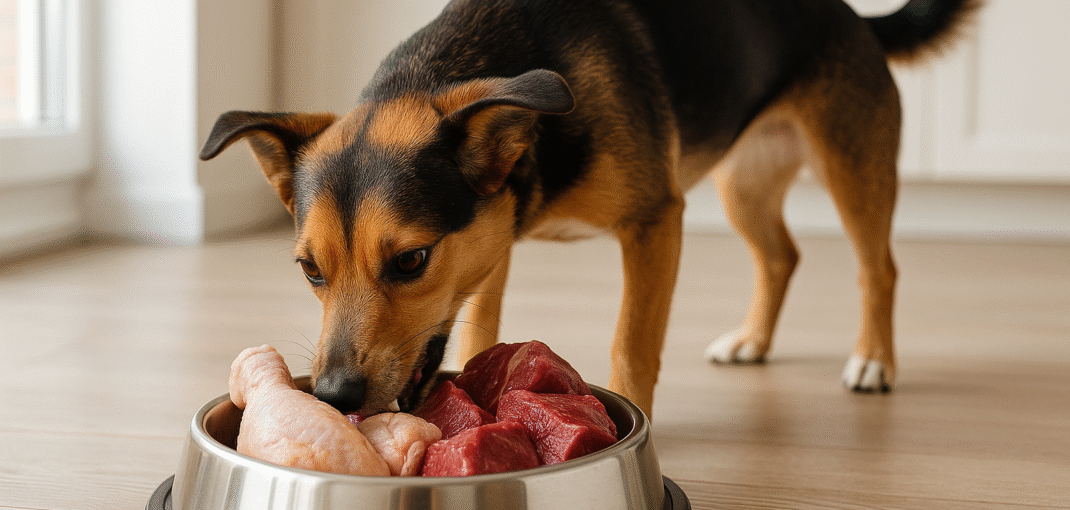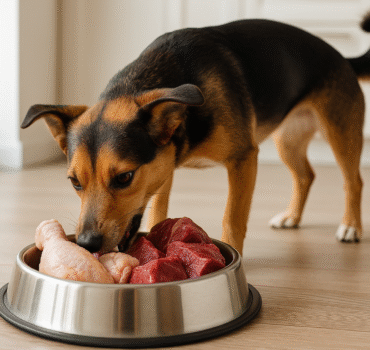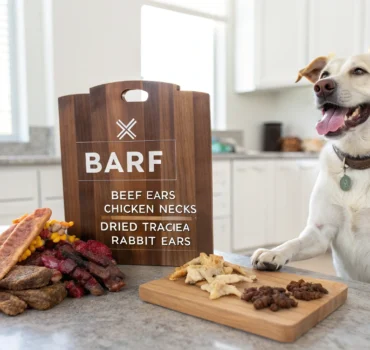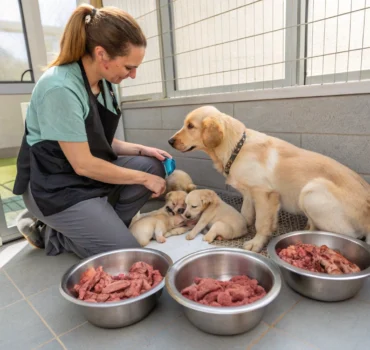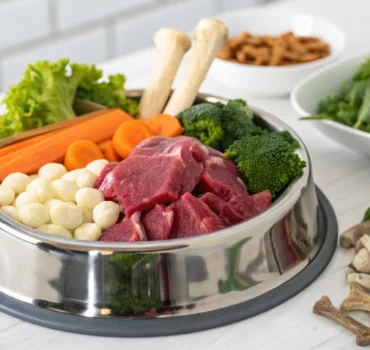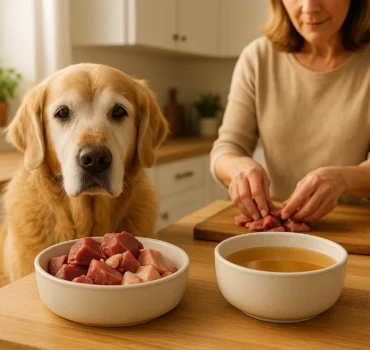A Simple Approach to Natural Canine Nutrition
Have you heard people talking about raw cut dog food and wondered what makes it different from regular raw feeding?
Raw cut is becoming one of the most popular ways to feed dogs naturally. It’s simpler than traditional BARF diets, more affordable than pre-made raw meals, and gives your dog all the benefits of eating real, unprocessed food.
The concept is straightforward: feed your dog raw meat in simple cuts, just like you’d buy for yourself at the butcher. No grinding, no complicated recipes, no expensive pre-packaged meals. Just real food in its natural form.
In this guide, you’ll learn what raw cut dog food is, how it differs from other raw feeding methods, and how to start feeding this way safely. Whether you’re new to raw feeding or looking for a simpler approach, this article will show you everything you need to know.
What Is Raw Cut Dog Food?
Raw cut dog food is exactly what it sounds like: feeding your dog raw meat in whole or chunked pieces rather than ground up. Think chicken quarters, beef chunks, whole fish, or lamb ribs. The meat stays in recognizable cuts instead of being processed into a mush.
This approach mimics how wild dogs and wolves eat. When a wolf catches prey, they don’t grind it up first. They tear into it, eating chunks of meat, crunching through bones, and consuming organs in their whole form.
The raw cut method focuses on simplicity. You’re not following complicated recipes or worrying about exact percentages of this or that. You’re just giving your dog real food in a form their bodies are designed to handle.
Many dog owners prefer raw cut feeding because it’s more natural and engaging for dogs. Chewing and tearing at food provides mental stimulation and dental benefits that ground food doesn’t offer.
It’s also more practical for many people. You can buy meat in bulk from local butchers or suppliers, portion it out, and freeze it. No special equipment needed, no hours spent preparing meals.
How Raw Cut Differs From Other Raw Feeding Methods
If you’ve researched raw feeding before, you might be confused about all the different approaches. Let’s clear that up.
Traditional BARF Diet: This method, developed by Dr. Ian Billinghurst, involves carefully balanced meals with specific ratios of muscle meat, bone, organs, and vegetables. Many people grind everything together to ensure balanced nutrition in every meal.
Prey Model Raw: This approach aims to replicate whole prey. Feeders give 80% meat, 10% bone, and 10% organs over time, but don’t include vegetables. The food is usually in larger pieces or whole prey items.
Raw Cut Method: This is similar to prey model but emphasizes feeding meat in natural cuts rather than ground. It’s less rigid about exact ratios and focuses on variety over time. The key difference is the texture and form of the food.
Commercial Raw Food: Pre-made raw meals that come frozen or freeze-dried. These are convenient but expensive and often ground into patties or nuggets.
Raw cut dog food sits somewhere between prey model and traditional BARF. It gives you flexibility while keeping things simple and natural. You’re not stressing about perfect ratios at every meal, but you’re still providing complete nutrition over time.
The biggest advantage? Your dog gets to eat like a dog. They use their teeth, exercise their jaws, and engage with their food in a way that feels instinctive.
Benefits of Feeding Raw Cut Dog Food
Switching to raw cut dog food offers numerous advantages for both you and your dog. Here’s what you can expect:
Better Dental Health: Chewing through chunks of meat and raw bones naturally cleans teeth. The tearing and gnawing action scrapes away plaque and tartar better than any kibble or ground food can.
Improved Digestion: Dogs have short, acidic digestive systems designed for raw meat. Raw cut food is easier for them to digest than processed kibble or even ground raw food. Many owners report firmer, smaller stools and less gas.
Mental Stimulation: Eating becomes an activity, not just fuel. Dogs have to work at their food, which satisfies their natural instincts and keeps them mentally engaged.
Shinier Coats: The natural fats and oils in raw meat lead to healthier skin and glossier coats. Many owners notice the difference within weeks of switching.
More Energy: Dogs on raw cut diets often have more consistent energy levels throughout the day. No sugar crashes or food comas like you might see with carb-heavy kibble.
Weight Management: It’s easier to maintain a healthy weight on raw cut food. The high protein content and lack of fillers mean dogs feel satisfied without overeating.
Reduced Allergies: Many dogs with food sensitivities improve dramatically on raw cut diets. When you control exactly what goes into your dog’s bowl, you can avoid problem ingredients.
Cost Effective: Buying meat in bulk cuts is often cheaper than pre-made raw meals or premium kibble. You’re paying for food, not packaging and processing.
These benefits aren’t just anecdotal. Thousands of dog owners report similar improvements when they switch to raw cut feeding.
Getting Started With Raw Cut Dog Food
Ready to try raw cut dog food? Here’s how to begin safely and successfully.
Start Simple: Choose one protein source for the first week or two. Chicken is usually the easiest to digest and most affordable. Buy chicken quarters, thighs, or whole chickens cut into portions.
Calculate Portions: Adult dogs typically eat 2-3% of their body weight daily. A 20kg dog would eat 400-600 grams of food per day. Adjust based on your dog’s activity level and body condition.
Transition Gradually: If your dog currently eats kibble, don’t switch overnight. Start with one raw cut meal per day while keeping other meals as kibble. Gradually increase raw meals over 1-2 weeks.
Include Variety: Once your dog adjusts to chicken, add other proteins. Beef, lamb, turkey, fish, and rabbit all provide different nutrients. Rotate proteins weekly or even daily.
Don’t Forget Organs: Liver, kidney, heart, and other organs are nutritional powerhouses. Include organ meat at about 10% of the total diet. You can give it in chunks or mix it with muscle meat.
Add Bones: Raw meaty bones provide calcium and dental benefits. Chicken necks, wings, and backs work well for most dogs. Larger dogs can handle beef ribs or lamb necks.
Monitor Your Dog: Watch stool quality, energy levels, and coat condition. These indicators tell you if the diet is working. Adjust portions and variety as needed.
Be Patient: Some dogs adapt immediately. Others need time. Give your dog at least a month on raw cut food before deciding if it’s working.
The beauty of raw cut dog food is its flexibility. There’s no single “right way” to do it. Pay attention to your dog and adjust as you learn.
What to Feed and What to Avoid
Not all raw cuts are created equal. Here’s what works well and what to skip.
Great Options:
- Chicken quarters, thighs, wings, necks, and backs
- Beef chunks, heart, liver, kidney, and tripe
- Lamb ribs, neck, and shoulder cuts
- Turkey necks, wings, and ground turkey with bone
- Whole fish like sardines, mackerel, or small trout
- Rabbit, duck, and other game meats when available
Use Caution:
- Weight-bearing bones from large animals (can break teeth)
- Pork (make sure it’s frozen for at least 3 weeks to kill parasites)
- Wild game (risk of lead shot or parasites)
- Very fatty cuts as the main diet (can cause digestive upset)
Avoid Completely:
- Cooked bones (these splinter and are dangerous)
- Seasoned or marinated meat
- Meat that’s gone bad or smells off
- Bones from cooked chicken or turkey
When shopping for raw cut dog food, think about what you’d be comfortable eating yourself. If the meat looks and smells fresh enough for your table, it’s good enough for your dog.
Buy from reputable butchers or suppliers who understand food safety. In Cyprus, you can find quality options at local butchers or through specialized pet food suppliers like Yummy Dog Food.
Meal Planning and Preparation Tips
Feeding raw cut dog food doesn’t have to be complicated. Here’s how to make it easy:
Bulk Buying: Purchase meat in larger quantities to save money. Many butchers offer discounts on bulk orders. Freeze what you won’t use within a few days.
Portion Control: When you bring meat home, divide it into daily portions before freezing. This makes feeding time quick and simple. Just grab a portion from the freezer the night before.
Rotation Schedule: Plan your protein rotation in advance. For example: chicken Monday and Tuesday, beef Wednesday and Thursday, lamb Friday, fish Saturday, organ meat mixed throughout.
Thawing Safely: Move frozen portions to the refrigerator 12-24 hours before feeding. Never thaw on the counter at room temperature. In a pinch, you can thaw in cold water.
Feeding Location: Raw cut food can be messy. Feed outside if possible, or use a designated area that’s easy to clean. Some people use large trays or feed in the bathroom.
Storage: Keep raw meat frozen until needed. Thawed meat should be used within 2-3 days. Store in sealed containers to prevent cross-contamination in your fridge.
Equipment: You don’t need much. A good knife for cutting larger pieces, a scale for weighing portions, and freezer-safe containers for storage. That’s it.
Time Management: Set aside an hour or two once a week to portion and prepare meals. This makes daily feeding quick and stress-free.
Many people find that raw cut feeding actually saves time compared to other methods. No cooking, no complicated prep, just real food served simply.
Safety and Hygiene Practices
Handling raw meat requires basic food safety practices. Follow these guidelines to keep everyone healthy:
Hand Washing: Wash your hands thoroughly before and after handling raw meat. Use soap and warm water for at least 20 seconds.
Separate Surfaces: Use different cutting boards and knives for dog food and human food. Or thoroughly sanitize between uses.
Clean Feeding Areas: Wash your dog’s bowl after each meal. Clean the feeding area regularly to prevent bacterial buildup.
Proper Storage: Keep raw meat at proper temperatures. Frozen meat should stay at 0°F or below. Refrigerated meat should be at 40°F or below.
Watch for Spoilage: Trust your nose. If meat smells off, don’t feed it. Better safe than sorry.
Protect Vulnerable People: If you have immunocompromised family members, pregnant women, or very young children, take extra precautions. Consider feeding your dog outside or in a separate area.
Dog Health: Healthy dogs handle bacteria in raw meat much better than humans. Their stomach acid is highly acidic and kills most pathogens. Still, practice good hygiene.
Parasite Prevention: Freeze meat for at least 3 weeks before feeding to kill potential parasites. This is especially important for pork and wild game.
These practices become second nature quickly. Most raw feeders report that safety concerns were overblown and that common sense is all you really need.
Troubleshooting Common Issues
Sometimes things don’t go perfectly when you start feeding raw cut dog food. Here’s how to handle common problems:
Loose Stools: Usually means you’re transitioning too fast or feeding too much organ meat. Slow down the transition and reduce organs temporarily.
Constipation: Often caused by too much bone. Reduce bone content and add more muscle meat. Make sure your dog has access to plenty of water.
Refusal to Eat: Some kibble-fed dogs don’t recognize raw meat as food at first. Try lightly searing the outside to create a smell, then gradually reduce cooking time.
Gulping Without Chewing: Dogs used to kibble sometimes gulp raw food. Feed larger pieces that force them to chew. Supervise until they learn to eat properly.
Messy Eating: This is normal, especially at first. Feed in an easy-to-clean area. Some dogs naturally eat cleaner than others.
Weight Loss: Increase portion sizes. Raw food is less calorie-dense than kibble, so dogs often need more volume.
Weight Gain: Reduce portions slightly. Monitor body condition and adjust as needed.
Picky Eating: Rotate proteins more frequently. Some dogs get bored eating the same thing daily. Variety keeps meals interesting.
Most issues resolve within a few weeks as both you and your dog adjust to the new feeding method. Don’t give up too quickly.
Conclusion: Simplify Your Dog’s Diet With Raw Cut Food
Raw cut dog food offers a straightforward path to better canine nutrition. No complicated recipes, no expensive pre-made meals, just real food in its natural form.
Your dog’s ancestors didn’t need nutritionists or food scientists. They ate what they caught, and they thrived. Raw cut feeding brings that simplicity back while fitting into modern life.
The benefits speak for themselves: better dental health, improved digestion, shinier coats, and happier dogs. Plus, you’ll save money compared to premium kibble or pre-made raw meals.
Starting is easier than you think. Pick a protein, calculate portions, and begin. Your dog will thank you with better health and more enthusiasm at mealtime.
Ready to give your dog the nutrition they deserve? Visit Yummy Dog Food for quality raw feeding options in Cyprus. We offer everything from complete BARF meals to natural treats that complement a raw cut diet. Check out our Special Beef Recipe, Special Chicken Recipe, and Special Lamb Recipe for convenient, balanced raw meals. Your dog’s health is worth it.
Frequently Asked Questions
Is raw cut dog food safe for all breeds and ages?
Most healthy dogs of any breed or age can eat raw cut food safely. Puppies can start as early as 4 weeks old with appropriately sized pieces. Senior dogs often thrive on raw cut diets, though those with dental issues may need softer cuts. The main exceptions are dogs with severely compromised immune systems, who should only eat raw food under veterinary supervision. Always consult your vet before making major dietary changes, especially for puppies or dogs with health conditions.
How much does it cost to feed raw cut dog food?
Costs vary depending on where you source your meat and your dog’s size. On average, expect to spend €1.50-€4 per day for a medium-sized dog. Buying in bulk from local butchers or suppliers significantly reduces costs. Many owners find raw cut feeding comparable to or cheaper than premium kibble, especially when you factor in reduced vet bills from improved health. At Yummy Dog Food, our complete BARF meals range from €3.50 to €6.50 per kilogram, making quality raw feeding affordable.
Can I mix raw cut food with kibble?
While many people successfully mix raw and kibble, it’s not ideal. Raw food and kibble digest at different rates, which can cause digestive upset in some dogs. If you want to feed both, consider giving them at separate meals (raw in the morning, kibble at night, for example). However, the best results come from feeding either fully raw or fully kibble. If budget or convenience is an issue, feeding raw cut food even a few times per week is better than not feeding it at all.
